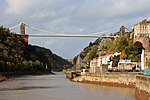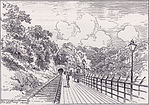Leigh Woods, Somerset

Leigh Woods is a village in the North Somerset district of Somerset, United Kingdom. It is just outside the boundary of the city and county of Bristol. The village is located to the south of Leigh Woods National Nature Reserve. It is situated at the western end of the Clifton Suspension Bridge, which opened in 1864, making the development of Leigh Woods as an upmarket residential area practicable. Houses in varying styles were built from the mid-1860s until the First World War. Styles adopted included Italian, neo-Jacobean, Scottish baronial, Swiss chalet, Modern glass buildings, Domestic Revival and Arts and Crafts.The village is in the civil parish of Long Ashton, but in the ecclesiastical parish of Abbots Leigh with Leigh Woods. The church of St Mary the Virgin was designed by the architect John Medland and built in 1891.
Excerpt from the Wikipedia article Leigh Woods, Somerset (License: CC BY-SA 3.0, Authors, Images).Leigh Woods, Somerset
Vicarage Road,
Geographical coordinates (GPS) Address Nearby Places Show on map
Geographical coordinates (GPS)
| Latitude | Longitude |
|---|---|
| N 51.453 ° | E -2.636 ° |
Address
Vicarage Road
Vicarage Road
BS8 3PH
England, United Kingdom
Open on Google Maps







